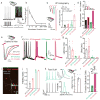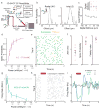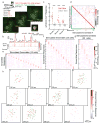Precise multimodal optical control of neural ensemble activity
- PMID: 29713079
- PMCID: PMC5970968
- DOI: 10.1038/s41593-018-0139-8
Precise multimodal optical control of neural ensemble activity
Abstract
Understanding brain function requires technologies that can control the activity of large populations of neurons with high fidelity in space and time. We developed a multiphoton holographic approach to activate or suppress the activity of ensembles of cortical neurons with cellular resolution and sub-millisecond precision. Since existing opsins were inadequate, we engineered new soma-targeted (ST) optogenetic tools, ST-ChroME and IRES-ST-eGtACR1, optimized for multiphoton activation and suppression. Employing a three-dimensional all-optical read-write interface, we demonstrate the ability to simultaneously photostimulate up to 50 neurons distributed in three dimensions in a 550 × 550 × 100-µm3 volume of brain tissue. This approach allows the synthesis and editing of complex neural activity patterns needed to gain insight into the principles of neural codes.
Conflict of interest statement
The authors declare that they have no competing interests.
Figures








Comment in
-
Sculpting light to reveal brain function.Nat Neurosci. 2018 Jun;21(6):776-778. doi: 10.1038/s41593-018-0158-5. Nat Neurosci. 2018. PMID: 29802389 No abstract available.
References
-
- Gollisch T, Meister M. Rapid neural coding in the retina with relative spike latencies. Science. 2008;319:1108–1111. - PubMed
-
- Bruno RM, Sakmann B. Cortex is driven by weak but synchronously active thalamocortical synapses. Science. 2006;312:1622–1627. - PubMed
-
- Harris KD, Mrsic-Flogel TD. Cortical connectivity and sensory coding. Nature. 2013;503:51–8. - PubMed
Publication types
MeSH terms
Substances
Grants and funding
LinkOut - more resources
Full Text Sources
Other Literature Sources
Molecular Biology Databases
Research Materials

